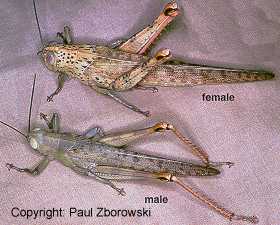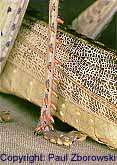Adult description 9 of 15


Size: Very large - Australia's biggest grasshopper. Females 60 to 75 mm, males 45 to 55 mm.
Adult Description: Colour creamy brown to grey with mottling often expressed as groups of small dark spots. In profile top of head and wings level, thorax with slight ridge along the top centre. Throat peg present. Wing covers mottled to spotty and the hind wings smoky grey. Rear tibia same colour as the rest of the leg but tibial spines are orange to red with black tips.
Confusion with Australian plague locust: Even at a distance they are much larger than plague locusts.
Confusion with Austracris: At first impression similar in size, shape and colour. Also has a throat peg (compare photos).Unique features: Valanga is very large and have rear tibia spines that are orange to red with black tips, as opposed to white with black tips in Austracris guttulosa. This in combination with a mottled body without a lighter stripe along the top of the body, two dark marks on the outside of the femur and smoky grey hind wings.
Further information on this species: Description of nymph
